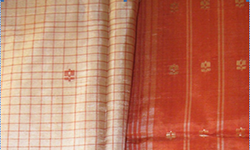Thoughts on The Vanishing GhaghraAll the women of Punjab, Haryana, Rajasthan wore the ghaghra till the early 20th century. The farming castes and nomadic tribes of Rajasthan continue to wear them today. Made from 24" wide triangles of khadi fabric, ghaghras were famous for the number of triangles orkalis (folds). A husband's love for his wife was measured by the number of kalis in a woman's ghaghra. The entire outfit comprised the ghaghra, choli (blouse) and the lugdi (dupatta). There was a whole sociology of colour and prints which functioned within an implicit understanding that fabrics too can be a language identifying a persons, community, caste, occupation and marital and religious status. Certain castes like the Jats wore indigo or "darker" colours while Rajputs wore sunhera (bright) colours like oranges and yellows. Sunhera colours were less, pucca (fast) as upper caste could get the Rangrez (dyer) to keep freshly re-dyeing their ghaghras with fresh flower smells of "tesu". This re-dyeing was a status symbol, the farmer castes wore blue as that was fast color and men usually bought their women one ghaghra per year. There used to be a saafa or head scarf of long yardages which men wore as turban. The most exotic was Maliagiri in whose dyeing more than twenty ingredients were used including attar or naturally condensed perfumes. We tried to recreate the malia... |
This is a preview. To access all the essays on the Global InCH Journal a modest subscription cost is being levied to cover costs of hosting, editing, peer reviewing etc. To subscribe, Click Here.




